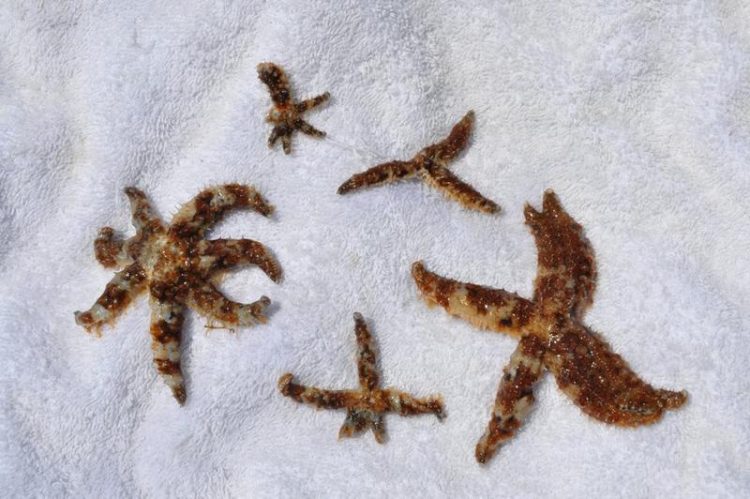Starfish that clone themselves live longer

Coscinasterias tenuispina starfish University of Gothenburg
In the study, researchers investigated the telomere lengths and population genetics of a starfish, Coscinasterias tenuispina. The telomeres are located at the ends of the chromosomes, and affect the lifespan and health of an individual.
The studied starfish exhibited both asexual and sexual reproduction. Asexual reproduction, or cloning, involves the starfish dividing itself into two or more parts, after which the new parts regenerate.
The researchers wanted to find out whether the populations that clone themselves the most have better health and signs of delayed ageing in relation to the populations that carry out more sexual reproduction. Both Mediterranean and Atlantic populations were studied.
“Our results from the genetic markers show that the starfish are more inclined to clone themselves in the Mediterranean,” says Helen Nilsson Sköld from the University of Gothenburg’s Sven Lovén Centre for Marine Sciences in Kristineberg. “In actual fact, there only appears to be a single clone off the Spanish Costa Brava. In the Atlantic, however, sexual reproduction is more common.”
Better health and a longer lifespan without sexual reproduction
There turned out to be a clear positive link between long telomeres and the level of clonality.
“We also noted that the telomeres were longer in the newly formed tissue than in the ‘old’ tissue in the same starfish,” adds Helen, who – together with Bethanie Carney Almrort – was one of the two researchers in the group from the University of Gothenburg.
“According to the researchers, this rejuvenation of the telomeres in connection with the formation of new tissue during cloning is probably one of possibly several explanations behind the particularly good health and long telomeres of clones.”
The principle behind the study, that clones avoid ageing by regulating telomeres, has also been previously studied by other researchers in flatworms.
“The strengths of our study are that we have confirmed these results in a completely different animal group, and that our data comes from wild populations,” she concludes.
The study was published in the May issue of Heredity, and was a collaboration between Swedish and Spanish researchers, including both biologists and medical researchers.
Link to the article: http://www.nature.com/hdy/journal/vaop/ncurrent/pdf/hdy201543a.pdf
Contact:
Helen Nilsson Sköld, The Sven Lovén Centre for Marine Sciences, Kristineberg
The University of Gothenburg
Tel.: +46 (0)31 7869547, helen.skold@gu.se
http://www.gu.se/english/about_the_university/news-calendar/News_detail//starfis…
Media Contact
All latest news from the category: Life Sciences and Chemistry
Articles and reports from the Life Sciences and chemistry area deal with applied and basic research into modern biology, chemistry and human medicine.
Valuable information can be found on a range of life sciences fields including bacteriology, biochemistry, bionics, bioinformatics, biophysics, biotechnology, genetics, geobotany, human biology, marine biology, microbiology, molecular biology, cellular biology, zoology, bioinorganic chemistry, microchemistry and environmental chemistry.
Newest articles

Combatting disruptive ‘noise’ in quantum communication
In a significant milestone for quantum communication technology, an experiment has demonstrated how networks can be leveraged to combat disruptive ‘noise’ in quantum communications. The international effort led by researchers…

Stretchable quantum dot display
Intrinsically stretchable quantum dot-based light-emitting diodes achieved record-breaking performance. A team of South Korean scientists led by Professor KIM Dae-Hyeong of the Center for Nanoparticle Research within the Institute for…

Internet can achieve quantum speed with light saved as sound
Researchers at the University of Copenhagen’s Niels Bohr Institute have developed a new way to create quantum memory: A small drum can store data sent with light in its sonic…





















